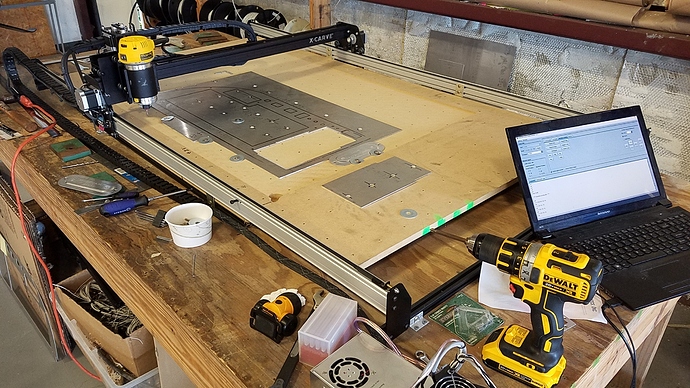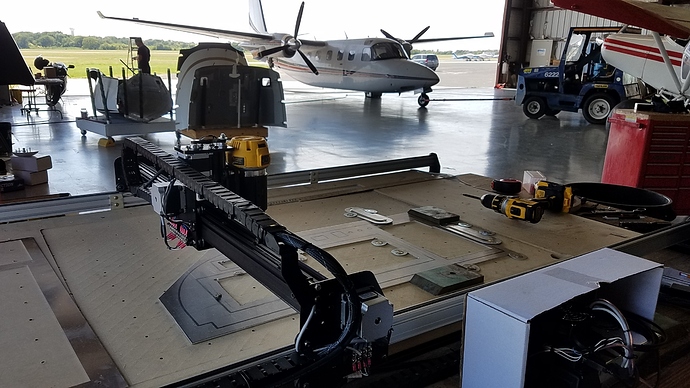I have not. That was one of my next options. I need to go find the 3in1 everyone keeps talking about.
Aspire, insure that you are using the inches per minute output setting for the xcarve. I am pretty sure this was my issue when I was getting to the 2nd and 3rd passes and out of the blue my xcarve would freak out and dive the bit as deep as it could go.
Using Aspire create an offset vector and place it 1 1/2 X you bit dia. To the side you want. And create a pocket TP. That will give you the spacing your looking for.
I don’t think i’m doing it right. I think im cramming too much info into my head all at once 
I should see the est time go up correct? So far it doesn’t change and i’m only able to get a few corners to actually pocket. Its not doing it evenly. When I copy and paste the vector, then resize it, it doesn’t size correctly leaving certain sides too big while other sides don’t change much at all.
Don’t copy and paste. Select the vector and then use your offset tab. It gives you the option of selecting the offset distance. And will do it evenly. I don’t have my laptop with me but maybe someone can post a photo of what I’m talking about.
Also… Go to YouTube and look up Vectrics channel. They have a ton of tutorial videos. And look up “work against the grain”. Jeff does a good job with his Aspire tutorials.
Well then that’s my problem. Someone said to copy and paste it so i’ve been trying to stretch and move… nothing is working. So the offset tab. I see there’s one on the left, and one on the right… I guess i’ll head over to youtube and see what i can find.
It’ll help. I’ve learned a ton from watching them.
Also. When your using a spindle with a manual speed dial , the settings in Aspire won’t do anything. That is used when you have automatic spindle control. And the tool number is used if you have a ATC (automatic tool changer).
Here is the speed setting chart for the Dewalt.
Learning so much with this thread! Any suggestions about my bit choice posted at top? I also have 1 and 2 flute bits. The 3f bit I’m using now is my only one and since it ran off twice, is it still usable? Even if it looks clear to the naked eye?
I would change to a 1 flute bit. The Dewalt is just to fast for a 3 flute bit in AL. The feed rate formula looks like.
Feed rate(ipm)= RPM X Number of Flutes X Chip Load.
So if your bit needs a chip load of .019 to stay cool then 16200 X 3 X .019 means you need to be moving at 923 IPM. Not on our machine any ways lol. So we need to do other things to help out. Get an air assist of some kind to constantly blow on your bit/work also keeps chips clear. Use a lot of lubricant and clear the chips very often. W/D 40 works good. The off set TP helps tremendously.
I see your stock is thin. Does it come in a roll?
I’ll give 1F a shot. Seems like everyone has their own ideas about what works and what doesn’t. I’m willing to try everything until I reach the right formula though. And no, .09 aluminum is way too thick to roll. It comes in a sheet 5x12 on a flat bed truck. Can you even cnc aluminum that rolls up??? Seems like that’d be thin enough to cut with sheers.
Lol that was my thought. But you said your boss ordered 25’ of it. It just struck me as off somehow.
Oh I see. Yea, I could see how that’d be taken wrong. We have two 12’ long sheets and chopped them down to manageable sizes. Hopefully i won’t screw up a bunch before i actually turn a good part out. This stuff isn’t cheap!
My thoughts for tomorrow when I get back into the shop are to switch to a 2F bit (it’s the only other Destiny Viper bit I have) and doing a 2 pass pocket for each cut out just to be on the safe side until I can figure out the correct speeds and feeds for a single pass on .090. I’d rather be turning out parts slowly than non at all.
Ah I see. I couldn’t figure out how it was 25’ long and .09" thick. Unless you had it delivered by train to your front door lol. Unless it’s super critical that you start turning out these parts immediately. You might try carving these parts out of some cheep plywood. There is a learning curve with these machines. You WILL make other mistakes. Better to make them on scrap than burn up needed material.
If you don’t have a mister or an air nozzle on your machine, a can of wd40 does well as a lubricant for cutting. Use the long straw type nozzle on the can and spray the cutting bit and along the path. It quiets a noisy cut, but requires manual attention.
Learned from a machinist who has been practicing his trade for 60 years, kerosene is a good liquid to use when cutting aluminum. It’s not so much a lubricant as a means to prevent galling of the cutter from the melted aluminum. An acid brush, also called a flux brush can be used to apply directly to the bit, or puddle it ahead of the cut path.
I too am a machinist albeit something of a lapsed one, and I too have used various solvents as lubricants, this is relatively common.
At the risk of posting another one of those over the top safety lectures, I felt that a little warning may be warranted on this subject at this point.
When using a hydrocarbon as a lubricant/coolant, I’ve also always been able to use a properly earthed machine that don’t suffer from static buildup, which has its motors, brushes and other sources of ignition, somewhat distant from the work area.
If you’re going to use a flammable solvent as a lubricant on your XCarve, BE DAMNED CAREFUL.
Have a delivery system that delivers tiny amounts, accurately.
Have a method of collecting the runoff (clamping your work piece inside a shallow oven tray can work).
Have a ventilation system in place. External doors and windows open with a fan is better than nothing.
WD40 can be used as an effective lubricant/coolant, but you must be aware that the can’s internal propellant is yet another hydrocarbon, either butane or something very similar.
All of these things are obviously flammable and for most X Carvers, their spindle is sitting just above their work area. I’m not suggesting that anyone shouldn’t use these techniques, but some basic safety steps should always be a part of any workshop (even if the ‘workshop’ is an XC in a spare room).
A 5kg dry powder fire extinguisher is only a few bucks. Mount it on the wall right next to the door.
Late edit.
Also be aware that many shop vacuums use the air that they suck as a coolant for their motor. Sucking flammable gases and fumes through a shop vac may be a really bad idea.
Using a shop-vac to suck up flammables is always a bad ideal. I remember when I was younger and an older man came into the shop after trying to use a shop-vac to remove old leaves from a model A gas tank that had been lying in his yard, when he stuck the hose in the tank (he said it was empty of gas for years) the tank exploded and shot off down the road. did not hurt him but scared the S**t right out of him. never forget the old man telling us that and wanting to know if we knew where he could get another tank.
SUCCESS!
First, I need to start out saying a HUUUUUUGE THANK YOU to Mr. @CharleyThomas for the tremendous amount of help he was to me this week. As it turns out, after purchasing his auto zero, I discovered he lives around 200 miles north of me. After talking to him all week long via email, he volunteered to drive down and help me get my machine tuned up for turning parts out. How do you say no to that?! It was an awesome two days of learning from him.
So, after a week of trying several panel cuts trying to get the combinations down to something that’ll do what I need it to do, I have finally found a winning formula! With Charley’s help getting my machine straight, my table correct, and my bits in order, together with the information found all across this forum, my very first CNC’d part is just about ready. After several successful and repeatable test cuts early this morning, I’ve decided to move on to my final piece and so far, it’s been spot on.
Thanks to everyone who’s contributed to my question as well as commented on others questions. Using the search box, I found several people who’ve posted within the last year with information I used to get to where I am at. So, here’s my combination of success. It’s by no means the best option, it’s just an option. One of many. Probably slower than most of you guys, but it works and it’s repeatable. I can even take the part out, mess with it, and then place it back down and continue back on track like it never moved which is awesome. Eventually i’ll find faster ways of getting these done, but for now, any panel we can put in a customers plane is a good day for all of us.
My formula:
.090 2024 aluminum
2f down cut Destiny Viper bit .125
Dewalt 611 speed 1
DOC .002 (slow, but turning parts out is better than more test panels stacked up)
FR 25" ipm
PR 10
Single channel (no fluting or widening the channel to relieve heat)
No oil
Worked like a champ! Takes a while, but so far it’s awesome!
Here’s a pic of some test panels I was using as well as the final panel still being worked. You can see the panel is so huge I finally figured out that I need to bolt it down in the middle or my cuts won’t work.
And by the way, a mini sharpie screws right up into the 611 with the chuck removed. Makes it AWESOME to draw out where my cuts are going to be, then remove the panel and cut out everywhere my bolts can go in the middle and not be in the way. Glad I found that out early on while searching for a way to accurately and quickly see if everything is good to go.




